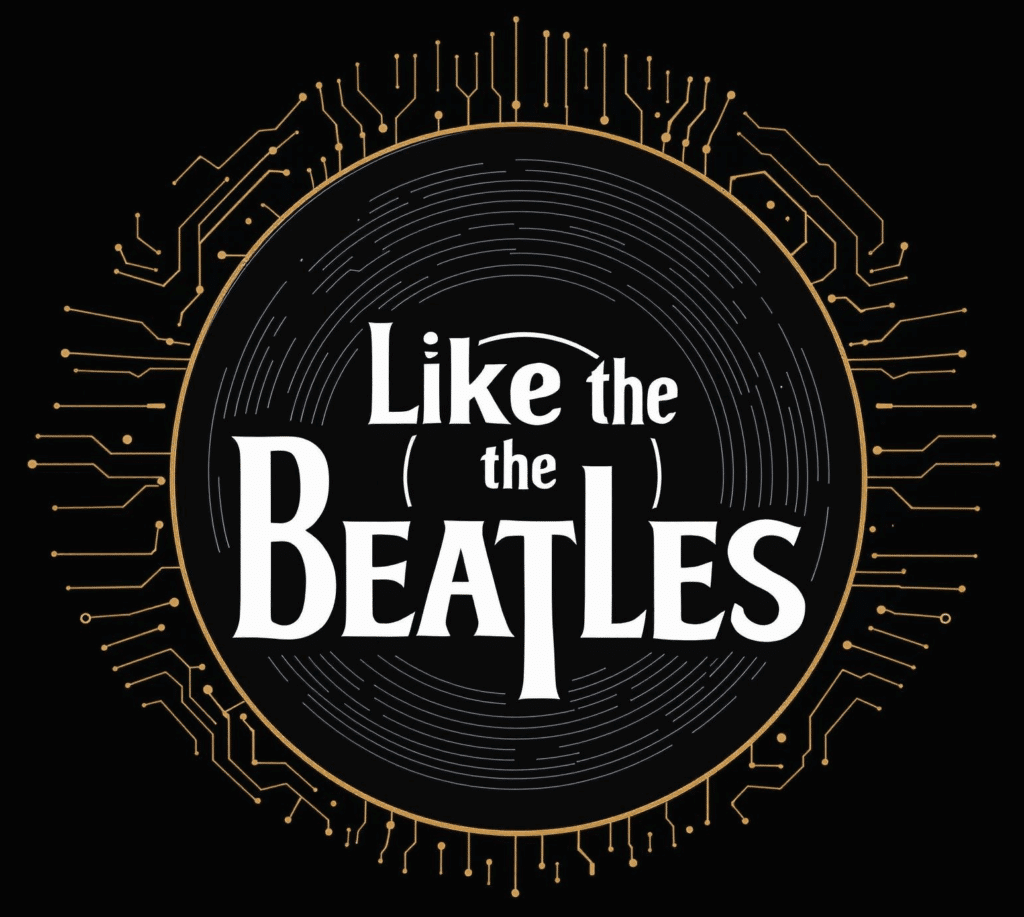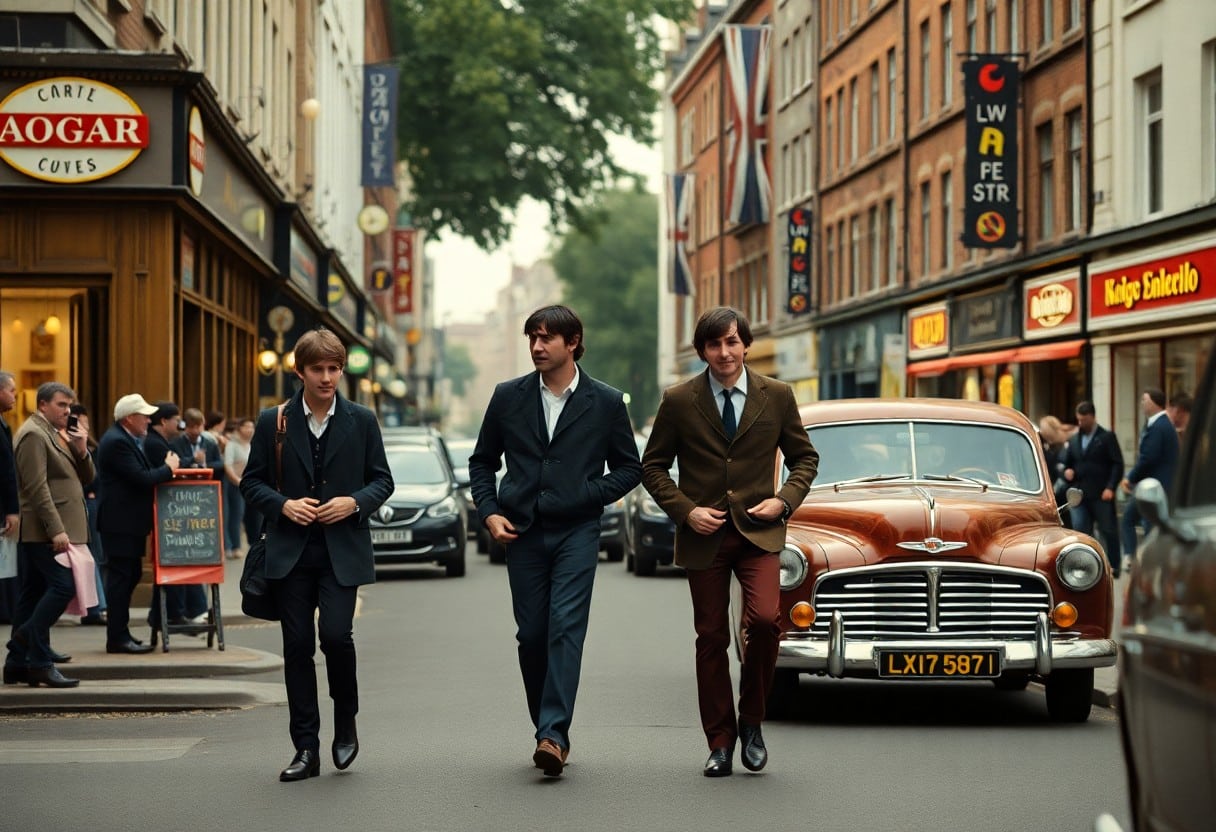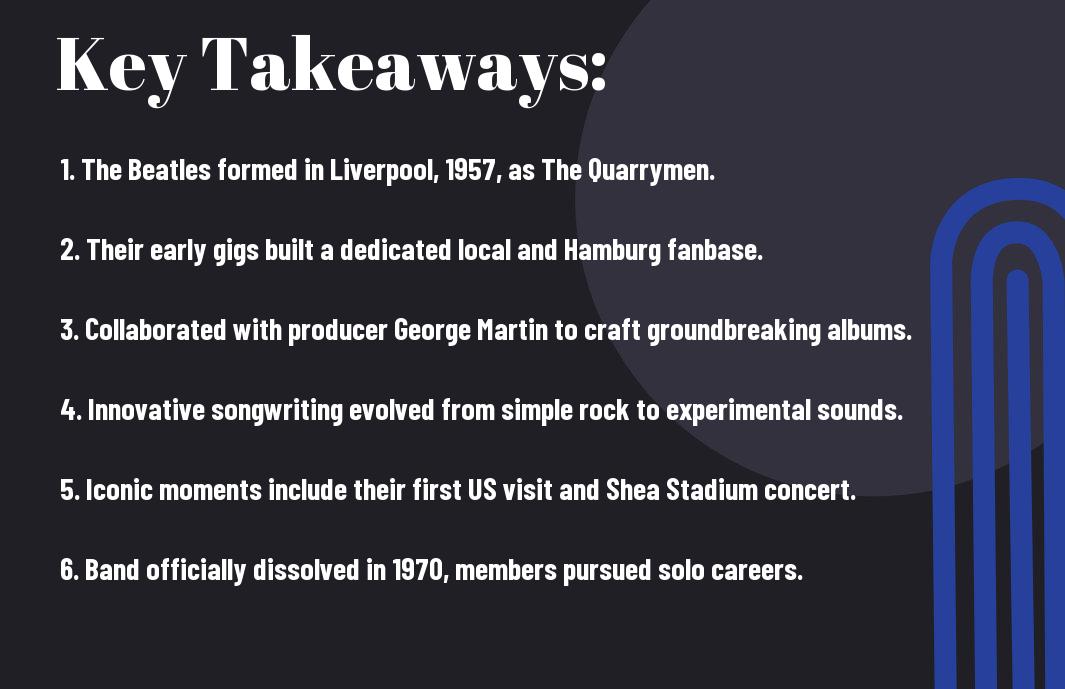Many fans of music find themselves captivated by the journey of The Beatles, a band that revolutionized the industry and continues to influence artists today. In this blog post, I will guide you through 10 fascinating steps that outline their incredible rise from humble beginnings in Liverpool to global superstardom. You will discover the pivotal moments, the challenges they faced, and the unique creative processes that defined their sound. By following their path, you can gain a deeper appreciation for their artistry and legacy.
The Early Days: Forming the Band
The journey of The Beatles began in the bustling streets of Liverpool, where the spark of rock ‘n’ roll ignited a passion that would captivate the world. As young musicians longing to make their mark, John Lennon and his friends formed the band The Quarrymen, setting the stage for an extraordinary evolution that would change music forever.
The Meeting of John and Paul
About a fateful day in July 1957, John Lennon and Paul McCartney first crossed paths at a church fete. Their meeting was more than just an encounter; it was a collaborative spark that ignited their lifelong friendship and musical partnership. Sharing a love for rock ‘n’ roll and a creative vision, they quickly realized they had found in each other the perfect collaborator to reshape popular music.
The Addition of George and Ringo
Between the early days of The Beatles’ journey, George Harrison and Ringo Starr joined the fold, bringing fresh talent and unique energy. George, initially a quiet yet gifted teenager, entered the band in early 1960, showcasing his impressive guitar skills. Shortly after, Ringo, with his charismatic drumming style, replaced Pete Best in 1962, solidifying The Beatles’ lineup. Their collective harmony set in motion a whirlwind of creativity and innovation that would define an era.
George was the young guitar prodigy whose passion for music was evident from the start. His addition to the band was transformative; he played an integral role in crafting their sound, infusing it with innovative guitar riffs and harmonies. Meanwhile, Ringo brought a distinct charm and upbeat rhythm to the band, instantly resonating with audiences everywhere. The dynamic between the four created a powerful synergy that became pivotal to The Beatles’ infectious appeal, fostering an atmosphere rich in creativity and collaboration.
Rise to Fame: Beatlemania
Now, as The Beatles erupted onto the scene in the early 1960s, their rise to fame marked the birth of Beatlemania—a fervor that captivated millions. With their catchy tunes, charming personalities, and revolutionary music style, they became the quintimportant symbol of a generation, sparking a cultural phenomenon that would reshape pop music forever.
The Release of “Please Please Me”
Behind the scenes, The Beatles were hard at work crafting their debut album, “Please Please Me.” Released in March 1963, this record showcased their raw talent and infectious energy, featuring hits like the title track and “I Saw Her Standing There.” It was a testament to their innovative songwriting and marked the official beginning of their undeniable influence on the music industry.
Touring and International Breakthrough
One of the defining aspects of The Beatles’ early career was their relentless touring schedule, which propelled them into the international spotlight.
Considering their intense performing schedule across the UK and beyond, The Beatles became a household name almost overnight. As they played in more than 250 concerts in just a few years, the energy and connection with their fans ignited a global obsession that permeated through radio waves and television screens. Their *first international breakthrough* came with a historic appearance on “The Ed Sullivan Show,” where they captured the hearts of over 73 million viewers. This moment solidified their status, marking the beginning of their influential journey in music history.
Musical Evolution: Experimentation and Innovation
Once again, The Beatles demonstrated their unparalleled creativity by constantly evolving their sound. They ventured beyond the confines of traditional pop music, delving into various genres such as rock, folk, and psychedelia. This spirit of innovation led them to experiment with new recording techniques and unconventional instruments, which fueled their artistic growth and set them apart from their contemporaries.
Influences and New Sounds
Influences from different musical genres and cultures shaped The Beatles’ distinctive sound. They drew inspiration from American rock and roll, Indian classical music, and even avant-garde elements, allowing them to forge a unique identity that captivated audiences worldwide.
Iconic Albums: From “Rubber Soul” to “Sgt. Pepper”
Iconic albums like “Rubber Soul” and “Sgt. Pepper’s Lonely Hearts Club Band” showcased The Beatles’ innovative approach and musical range. Due to their willingness to push boundaries, “Rubber Soul” was a turning point, reflecting their growth as songwriters and musicians. This was followed by “Sgt. Pepper,” which introduced groundbreaking recording techniques and a concept album format that redefined the music landscape. These albums not only solidified their legacy but also influenced countless artists, showcasing their ability to merge creativity with technical mastery. The Beatles left an indelible mark, transforming the way we perceive and experience music.
Cultural Impact: The Beatles as Icons
To appreciate the lasting significance of The Beatles, it’s crucial to recognize how they transcended music and emerged as powerful cultural icons. Their influence spanned fashion, film, and the very fabric of social change, shaping a generation and beyond. The Beatles challenged norms, inspiring fans worldwide to embrace self-expression and individuality.
Fashion, Film, and Social Change
Icons like The Beatles revolutionized fashion throughout the 1960s, introducing styles that reflected youthful rebellion and freedom. Their films, particularly “A Hard Day’s Night,” not only showcased their musical talents but also captured the zeitgeist of a transformative era. The band’s evolution mirrored the explosive social changes of the time, from the rise of anti-establishment sentiments to the embrace of new cultural ideals.
Engagement with the Counterculture
Behind their cheerful melodies lay a profound engagement with the counterculture, which further solidified their status as symbols of change. As I explore deeper into their artistic output, it becomes clear that they not only mirrored societal shifts but also actively participated in them. Their embrace of *Eastern spirituality*, drug culture, and *anti-war sentiment* resonated with a generation longing for alternatives to mainstream values.
Social movements flourished during the 1960s, and The Beatles stood at the forefront, utilizing their platform to challenge the status quo. They openly experimented with *psychedelic drugs*, which influenced their music and artistic expression. Their lyrics began to reflect deeper ideas about *peace*, *love*, and *personal freedom*, engaging fans in dialogue on *existentialism* and *social justice*. By holding a mirror to the changing world, The Beatles became a powerful force in shaping a culture hungry for change, illustrating just how intertwined art and activism can be.
Challenges and Conflicts: The Beginning of the End
For The Beatles, the late 1960s marked a tumultuous period where the unity that forged their early success began to fray. As fame escalated, so did the pressures from the media, management, and each other. Internal disagreements over creative direction, personal ambitions, and lifestyle choices accelerated the band’s path toward disbandment. This chapter embodies the struggles they faced, showcasing how their individual journeys began to outweigh their collective purpose.
Inner Tensions and Breakthroughs
Above all, the inner tensions within The Beatles grew as each member sought artistic freedom. As their music evolved, so did their identities, leading to both moments of intense creativity and profound conflict. I realized that the innovative spirit which once united them started to feel like an impediment, creating rifts that were hard to mend. This time was marked by breakthroughs that would redefine rock music, but the personal strains overshadowed the group’s harmony.
The Decision to Stop Touring
Inner conflicts led to a pivotal choice: The Beatles decided to stop touring in 1966. The relentless schedule and immense pressure took a toll on their mental health and creativity. I can understand why they chose to focus on the studio, creating deeper, more complex music rather than compromising their artistry on stage. This decision was significant, marking a shift in how they approached their craft. However, the implications of their choice fueled the band’s internal struggles, as fans were left wanting more of their captivating live performances.
But the real implications of stopping touring were profound. The band faced intense scrutiny from the media and fans eager for their dynamic energy. While on one hand, this decision allowed them to explore innovative sounds, it also created a void in the public’s expectations. I understood that without the adrenaline of live performances, personal tensions intensified, leading to heightened insecurities and further creative rifts. Ultimately, it was a turning point that foreshadowed their impending disbandment, as the thrill of live music gave way to studio-driven tensions.
The Final Years: Solo Careers and Legacy
All great stories have an ending, and The Beatles’ journey transitioned into unique solo careers that shaped individual legacies. Each member explored a personal artistic direction while still echoing their shared history. For a deeper understanding of how these foundational years set the stage, check out Following in The Beatles Early Footsteps – Pt 1 Getting to ….
Releases and Collaborations Post-Band
The Beatles’ disbandment in 1970 marked the beginning of a vibrant tapestry of individual artistic expressions. John Lennon’s introspective work, Paul McCartney’s melodic pop, George Harrison’s spiritual journeys, and Ringo Starr’s playful tunes all showcased their unique voices while occasionally crossing paths in collaborative efforts.
Lasting Influence on Music and Culture
On a broader scale, The Beatles left a lasting imprint on music and popular culture that continues to resonate today. Influencing countless artists across genres, their innovative sounds and styles helped to reshape the landscape of modern music.
In addition to their musical contributions, The Beatles revolutionized cultural norms and sparked a global movement that engaged with societal issues such as love, peace, and individuality. Their ability to blend a multitude of genres and deliver profound messages in simple tunes meant they inspired generations. The impact of their work is evident, not just in charts, but in fashion, film, and social movements, making them icons beyond their time.
Final Words
So, as we’ve explored the 10 fascinating steps to follow The Beatles’ path from beginning to end, I hope you’ve gained valuable insights into their remarkable journey. By understanding their creative process, cultural impact, and evolution as artists, you can appreciate the legacy they’ve left behind. Whether you’re a long-time fan or just starting to explore their music, I encourage you to dive deeper into their story and see how their experiences can inspire your own artistic endeavors.












